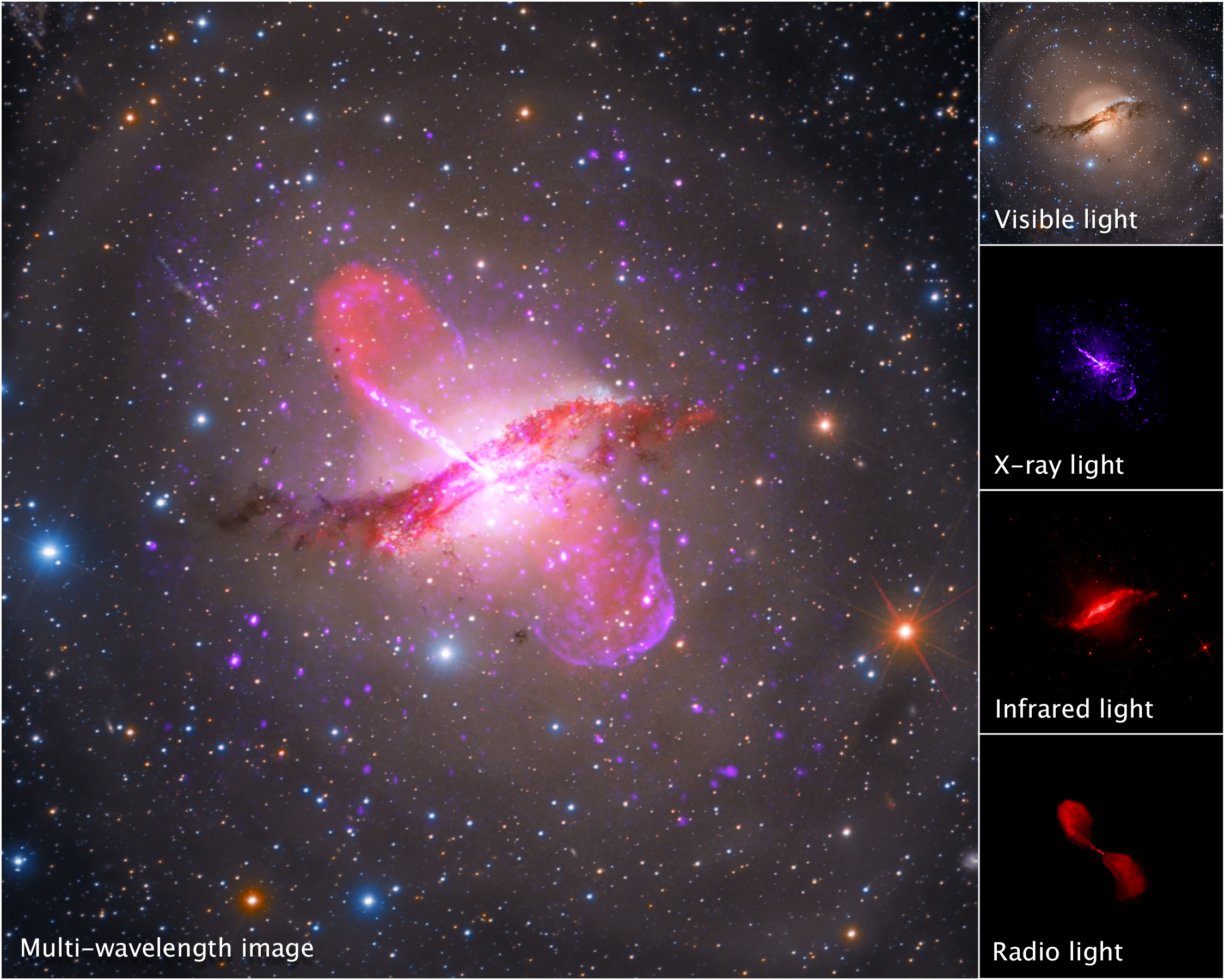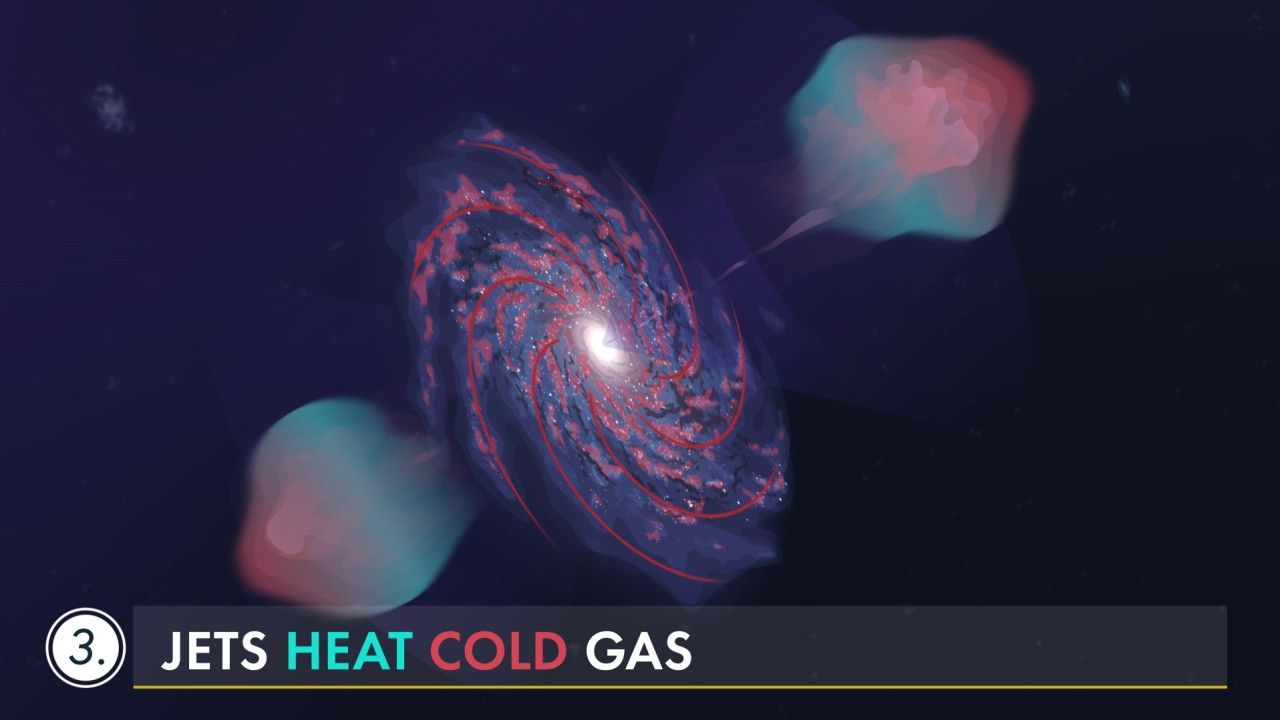1 min read
Dissecting Supermassive Black Holes

Supermassive black holes, which lie at the centers of galaxies, are voracious. They periodically “sip” or “gulp” from the swirling disks of gas and dust that orbit them, which can result in massive outflows that affect star formation locally and farther afield.
When NASA’s James Webb Space Telescope begins observing galaxies’ cores, its infrared instruments will pierce through the dust to deliver images and incredibly high-resolution data that allow researchers to learn precisely how one process sets off another, and how they create an enormous feedback loop.
Walk through the full process to learn how supermassive black holes convert fuel to produce bipolar jets, discover when star formation starts and stops, and examine a diagram of the processes at work.
Files for this large-scale infographic are available on this page under "Download Options" to print and post on your wall! All sections of this infographic ("Converting Fuel," "Pinpointing the Flows," "Conditions for Star Formation," and "The Feedback Loop") are also available for download in our collection of images.
Extended Description and Image Alt Text
Extended Description
Infographic titled “Dissecting Supermassive Black Holes” is split into four sections, with a large illustration running along the left side.
Introduction text: Supermassive black holes, which lie at the centers of galaxies, are voracious. They periodically “sip” or “gulp” from the swirling disks of gas and dust that orbit them, which can result in massive outflows that affect star formation locally and farther afield.
When NASA’s James Webb Space Telescope begins observing galaxies’ cores, its infrared instruments will pierce through the dust to deliver images and incredibly high-resolution data, which will allow researchers to learn precisely how one process sets off another, and how they create an enormous feedback loop.
A large illustration dominates the left side of the infographic. It shows a large spiral galaxy with blue, light blue, and white circles, and is dotted with white stars. At the center, the galaxy is bright white. From that area, two very long pink jets of cold gas extend in opposing directions, to the top and toward the lower area. The pink jets are thin where they begin near the center of the galaxy, but become larger, more circular, and fluffier, in various shades of pink the farther out they are. The jets are each about a third of the size of the overall galaxy. Around these pink jets are dark purple cones, which signify where stellar winds may be.
Three yellow open circles placed on the illustration connect via yellow lines to text on the right side. At the center, the yellow circle connects to the top-right section titled “Converting Fuel.” A yellow circle in the pink gas at the top connects to the middle section titled “Pinpointing the Flows.” A yellow circle in the middle of the galaxy’s spiral arm connects to the bottom section “Conditions for Star Formation.” At the bottom, a section separated from the rest of the infographic by a line is titled “The Feedback Loop.”
Top-Right Section: Converting Fuel
From the section title “Converting Fuel,” a yellow line ending in an open circle extends to the center of the galaxy in the main illustration at left.
Text: Supermassive black holes feast upon the swirling disks of gas and dust that orbit them. Webb’s high-resolution infrared data will reveal what this activity, which is driven by gravity, leads to.
Three smaller illustrations show more detail about what is happening at the center of the galaxy.
The left graphic shows a complete black circle at the center. From inside to outside, gray, pink, dark gray, blue, and purple swirls surround it. Two yellow arrows trace the clockwise movement in this central region, beginning in the bottom right corner and following the circular flows to the center.
The middle graphic shows the same scene with minor changes: The black circle is now partially obscured at the bottom by a brighter white central region. The yellow circular arrows reflect the same placement.
The right graphic shows the same partially obscured black central circle and large white region, but a semi-transparent blue cone begins at the center and widens out, ending toward the top of this image. A far thinner white-and-pink jet also extends from the black circle and goes to the top of the image.
Text continues: How efficiently do they convert energy into light after all that “eating”? How does this infrared light, which spreads like a halo from the galaxy’s core, impact the galaxy around it?
How are bipolar jets, which can double the amount of light they emit within a few hours, launched? Webb will help us better understand how black holes shape their galaxies overall.
Middle-Right Section: Pinpointing the Flows
The “Pinpointing the Flows” header connects with a yellow line ending in an open circle to the pink, fluffy jet shown in the main illustration at left.
Text: Webb will separate the light of active supermassive black holes from the light of their galaxies for the first time—including some of the earliest galaxies in the universe.
A diagram represents an outline of the illustration at left, but turned ninety degrees to the right. The purple galaxy is outlined and labeled at the center. Immediately to the left and right are two yellow cones. The yellow cones are approximately the same size as the galaxy and are labeled “Winds.” Dotted blue-green circles that extend to the left and right, and are slightly larger than the galaxy itself, are labeled as “Cavities” on both sides. Slightly smaller, fluffy pink circles inside the blue-green lines are labeled as “Jets” on both sides. A line pointing toward the base of the jet in the center of the galaxy is labeled “Light-hours across.” A white line from the center of the galaxy extends toward the right of the image, in the center of the fluffy pink jet, and ends in an arrow. The end of the arrow is labeled “Hundreds of thousands of light-years across.”
Text continues: Jets launched by supermassive black holes can be as small as a few light-hours across, but stretch up to hundreds of thousands of light-years into space.
Supermassive black holes can also drive broad, wispy winds into the galaxy. Webb will identify and analyze the contents of the bubble-like cavities in the gas surrounding the galaxy to pinpoint where the winds passed through.
Bottom-Right Section: Conditions for Star Formation
A yellow line ending in an open circle connects the “Conditions for Star Formation” header to an area in the blue-and-white spiral galaxy in the main illustration at left.
Text: Temperatures just above absolute zero are essential for star formation, but jets and winds from supermassive black holes can heat up cool gas, squashing the possibilities for star formation.
Two graphics illustrate the differences between hot and cold gas: At left, the image is titled “Before black hole outflows.” This area of star formation has a blobby distribution of color. Some areas are shown in gray and some in various shades of pale purple and pink. White stars appear in clusters or alone throughout the scene. In the image, the label “Cold gas and dust lanes” points to one of the darkest lanes on the left side.
At right, a second illustration is titled “After black hole outflows.” It is a mix of medium blue-green and darker gray colors. The colors vary, but are more evenly distributed. White stars also appear throughout this illustration, but are distributed irregularly with fewer clusters. The label “Hot, transparent gas” points to a lighter blue-green area at left.
Text continues: How quickly does star formation resume? How strongly do jets quench star formation? Webb’s measurements will help us determine when it picks up.
The observatory will also help us untangle when star formation resumes after these winds pass through galaxies.
Bottom Section: The Feedback Loop
Text: Learn how active supermassive black holes affect their galaxies—and everything up to hundreds of thousands of light-years away—in a practically never-ending loop.
At right, color-coordinated labels appear next to a yellow hexagon. The words “Cold gas” are set off in red text and represent “10 to 20 degrees above absolute zero. (This is Webb’s specialty.)” Below this, the words “Hot gas” are set off in blue-green text and represent “1 million degrees.”
Six illustrations represent each numbered step:
- A spiral galaxy with red and blue arms has a white center. A small red arrow travels clockwise at the center to indicate the motion of the gas. Text: Stars form from very cold gas, which is detected in infrared light. Very cold gas also falls onto the supermassive black hole.
- The same spiral galaxy appears, but includes bipolar purple cones that end in pink gas. Two additional straight blue-green arrows, pointing to the top and bottom, show the fluffy pink jets extend from the white center of the galaxy. Text: As a result, supermassive black holes launch outflows in the form of radiation, jets, and wind.
- The same galaxy, cone, and arrows appear, but now the fluffy gas at top and bottom are blue-green nearer to the galaxy, and pink at the farthest edges. Text: These outflows heat the cold gas.
- The galaxy is now blue overall. The purple cones indicating the winds still appear, but the arrows do not appear. The fluffy jets are now almost completely blue-green. Text: Once the gas is heated, star formation stops. The heated gas also stops falling onto the supermassive black hole.
- The galaxy again has some cold, red gas and a small red arrow indicates movement is clockwise at the center. The fluffy jets are blue-green at the top and bottom, but are becoming redder closer to the galaxy. Large purple, bipolar cones still indicate winds. Text: Over time, the gas cools, eventually allowing stars to begin forming again.
- The same spiral galaxy shown initially, with red and blue arms, and a white center, is shown again. The illustration does not contain the fluffy jets or cones. Text: The cycle repeats—again and again, over billions of years.
Image Alt Text
A large-scale infographic titled “Dissecting Supermassive Black Holes” has several sections with inset images and supporting text that details the activities of active supermassive black holes.
- Release DateMarch 17, 2021
- Science ReleasePeering into a Galaxy’s Dusty Core to Study an Active Supermassive Black Hole
- CreditImage: NASA, ESA, CSA, Leah Hustak (STScI)
Related Images & Videos

Multiwavelength View of Centaurus A (Hubble, Spitzer, Chandra, VLA)
Centaurus A sports a warped central disk of gas and dust, which is evidence of a past collision and merger with another galaxy. It also has an active galactic nucleus that periodically emits jets. It is the fifth brightest galaxy in the sky and only about 13 million light-years...

Centaurus A in Different Wavelengths (Hubble, Spitzer, Chandra, VLA)
A breakdown of a multi-wavelength image of galaxy Centaurus A shows light collected by Hubble (visible), Chandra (X-ray), Spitzer (infrared), and the Very Large Array (radio). Centaurus A's dusty core is apparent in visible light, but its jets are best viewed in X-ray and radio...

Dissecting Supermassive Black Holes: The Feedback Loop
Watch as the jets and winds from a supermassive black hole affect its host galaxy—and the space hundreds of thousands of light-years away over millions of years. Explore our image and video collections to find more videos in this series, including " Pinpointing the Flows ,” and...
Share
Details
Laura Betz
NASA’s Goddard Space Flight Center
Greenbelt, Maryland
laura.e.betz@nasa.gov
NASA, ESA, CSA, Leah Hustak (STScI)






























